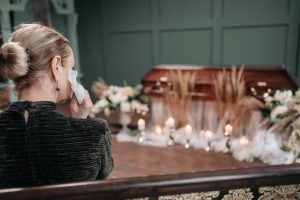3.2 Death Rituals & Ceremonies
Death Rituals
“Death ceremonies are rites of passage for both the deceased and for the living” (Irwin, 2015, p. 121). Ritualistic practices around death involve activities and behaviour that are performed or engaged in to mark the significance of the loss to the bereaved and the community. Death rituals commence the moment a person is declared dead, although definitions of death vary historically and cross-culturally (Palgi & Abramovitch, 1984). Depending upon cultural practices, many of which are tied to religious beliefs, such rituals can involve: preparing of the body (e.g., it may be washed by family or community members or professional funeral staff; it may be dressed, kept naked, or wrapped in a burial shroud; it may be embalmed; etc.); watching over the body (e.g., pre-burial vigils); a funeral and body disposal (e.g., burial, cremation, etc.); prayer; a mourning period; ritual providing of food (i.e., feasting); and celebratory events (Cohen, 2002). Death rituals provide bereaved individuals and the community with time to process their loss and acclimate to the dramatic changes associated with that loss, including alterations in status or identity, such as moving from the status of married to widowed after the death of a spouse.
Grief & Mourning Rituals

Grief and mourning rituals typically begin shortly after death. As detailed in the next chapter section, depending on culture and religion, grief rituals can take a variety of forms before, during, and after a funeral ritual and body disposal.
According to Irwin (2015), mourning and grief rituals serve several important purposes. They provide the bereaved an opportunity to acknowledge and share their experiences of loss, as well as their memories of the relationships they had with the deceased (Irwin, 2015). They facilitate the offering of support and comfort to the bereaved, and they serve as a means through which to express loss (Irwin, 2015). As part of death rituals, we often see the open unrestrained expression of grief through the release of emotion (Wojcik & Dobler, November 1, 2017).
Throughout history and cross-culturally there are numerous examples of ritualized public outpourings of emotion, many of which take oral and physical forms, as part of the process of meaning-making and coping with death (Gamliel, 2014a & 2014b; Mitima-Verloop et al., 2021). For example, loud vocal expressions of grief such as “death wailing”, “keening”, “lamenting”, and “chanting” can begin shortly after death and last until after the burial. Or they can occur at rituals that take place prior to funerals and body disposal and during the gatherings that often occur after these events. Such public rituals of sorrow are a “powerful way to give voice to the impact of the…loss on the wider community” (Wojcik & Dobler, 2017, para. 12) and can have a cathartic, grief releasing effect for participants and observers (McLaughlin, March 18, 2018; Sautter, 2017). An example of a traditional ritual emotional outpouring that is still practiced today, is the Haka chant dance of the Māori of New Zealand. The Haka is used for a variety of purposes, but it is “an integral part of the Māori mourning process…. Show[ing] love and compassion…and uplift[ing] the spirts of bereaved families (Māori Funeral Rituals, n.d.).
Click the link below to see the Haka being performed by friends and family, at the end of a funeral for a teenager from the Māori community.
Teenager Breaks Down in Tears During Memorial Māori Haka
Wailing, keening, lamenting performances, as traditional parts of expressing grief, are evident in various cultures historically and, to a lesser extent, today. A few examples include the keen, or lament for the dead that is at the core of traditional Irish wakes, and the ancient wailing practice of Yemenite-Jewish women (Mclaughlin, March 18, 2018; McLaughlin, 2019). These rituals are/were typically carried out by women, who are/were paid for their mourning services (Gamliel, 2014b; McGarry, August 19, 2021; Mendoza, February 15, 2018). Although there is much historical and cultural variation in the roles and styles of professional mourners, these individuals played an integral role in both pre-funeral events and funeral services (Natan-Yulzary, 2021).
VIDEO: Professional Mourners of Sardinia
The following video illustrates one form of professional mourning and the role it can play in a culture.
Today, professional mourners are still used in various parts of the world. You can rent a mourner in Essex UK, China, and even in the United States at the Golden Gate Funeral Home in Texas (Mendoza, February 15, 2018). Professional mourners are hired to provide the oral expression of emotion at a pre-funeral event and/or at a funeral (May, n.d.) and/or increase the number of people in attendance at a funeral (Mendoza, February 15, 2018). In cultures where public expression of emotions by the bereaved are viewed as inappropriate, such as in Taiwan, professional mourners may be hired to express emotions for the family (Dicken, 2021). Paid mourning services are, however, not always sombre and emotional, they can also provide entertainment through music, dance, etc., for funeral attendees as they celebrate the life of the deceased (Keyl, 1992).
Click the link to learn more about the role of professional mourners:
Paid for Their Tears: The Peculiar Profession of Professional Mourners
Rites of passage are ceremonies "that individuals go through to mark the change from one status of life to another" (Sociology Guide, n.d., para. 1).

